15.1 – Context
I understand we concluded the previous chapter by hinting that we would discuss Index funds next. However, I’m taking a bit of a detour to introduce how one can invest in Bonds directly.
Why am ‘I doing this now? Well, that is because we have just discussed debts funds and the associated terms, given the similarity between debt funds and bonds, I thought we could extend that discussion and talk about bonds as well.
Besides, Zerodha’s bond investing platform is up and ready for you to use, so this chapter will help you understand how to use the platform as well.
Remember, when you invest in any sort of debt mutual fund, you primarily invest in a mutual fund whose fund manager invests your funds in various bonds and bills. Using Zerodha’s platform, you can now directly invest in the bonds, just like the fund manager would.
15.2 – The bonds platform
The bonds platform on Zerodha is a part of Coin, our mutual fund platform.
On the landing page, you can see that we are talking about high-quality PSU and Corporate Bonds. High quality here means the highest credit ratings.
At any given point, the platform lists all the available bonds for you to invest. As of today, these are the bonds available to you –
For example, the very first is a bond from Rural Electrification Corporation Limited (REC).
There are two tags below the company’s name; these tags give you vital information on the bonds.
- PSU Tax-free – Remember, PSUs carry an implicit Sovereign guarantee; hence the credit risk in these PSU bonds is very low. The tax-free bit indicates that the interest income received from these bonds is 100% tax-exempt. The tax-free bit makes these bonds extremely attractive for the investors. However, the tax-free is applicable only for the interest income. If you hold the bond till maturity, there will be no taxation on your interest earnings from this bond. However, if you manage to sell this bond before maturity at a price more than what you had purchased, then you get capital gains which are taxable.
- Credit Rating – REC Limited’s bond is rated triple-A (AAA) by CRISIL; the rating is an indication of the creditworthiness of the borrower. AAA is the highest-ranking, so one need not worry about the creditworthiness of the borrower, i.e. REC in this case.
Apart from these tags, there are other specs available to you. Some of these are easy and intuitive, while the others are not.
On the platform, you can see a summarized view of the most important parameters for you to consider before investing. A typical investor does not need any more information apart from what’s listed above.
However, for the sake of this chapter and its completeness, let’s dig into more details of this particular REC bond. The ISIN of this bond is INE020B07HO1, key in the ISIN here and you’ll get all the other information related to this bond.
I’ve highlighted the most significant bits here –
Let’s start with the first item from the left. As we can see, this is a secured debt. A secured debt is a loan backed by security. The classic example is a Gold loan.
In a gold loan, you pledge the gold and raise a loan against it. When you repay the loan, the pledge on gold goes away, and you get back the gold. In case you don’t repay the loan, the lender is free to take your gold and make good for his loss.
Given this, if you look at it from the lender’s perspective, a secured debt gives the lender a higher comfort compared to unsecured debt.
In the next section, you can see that this is senior debt.
Every company has something called ‘Capital Structure’. The capital structure is like a leader board of sorts, which mandates the list of stakeholders who have the highest claim on the company’s repayment and earning structure.
The senior secured debt sits right at the top of a capital structure, while a common stock (equities) sits right at last. Between the senior debt and equity, lie other stakeholders like the unsecured debt, convertible bonds, non-convertible debt etc. In case of liquidation of the company (worst case scenario), the senior debt holders are the first ones to be paid off from the liquidation amount of the company. This significantly enhances the safety of capital for senior debt holders.
So the moment you see secured senior debt, be assured that the credit risk associated is relatively very low.
The section after this is quite self-explanatory, talks about the date of issue. Think about this as the company’s IPO date or an NFO debuting in the MF market.
REC paper was issued in 2013, maturing in 2023, making this a 10-year bond.
Now move your attention to the details mentioned on the right — the topmost section details out a few essential parameters.
Firstly, the face value, which is Rs.1000/-. The face value of a bond is essential for three reasons –
- Gives you a sense of the premium or discount the bond is trading to its face value. In the case of REC (refer to the snapshot from COIN), the current price for this bond is Rs.1115.03/-, which is at a premium to face value.
- The coupon is paid as a percentage of the face value. The coupon for this bond is 8.01%, which means that every bond you hold gives you Rs.80.01/- as interest income until it matures.
- Upon maturity, the redemption value depends on the bond’s face value. More on this later.
The next section highlights the interest payment details. As highlighted, the REC bond pays the interest on 1st Dec every year, till the bond matures. The company pays out interest annually. Some bonds pay interest semiannually, quarterly, and some even pay monthly.
You can also see the maturity date, which is 24th September 2023.
Now that you know these details, I’d suggest you re-look at the COIN snapshot. Everything mentioned in the snapshot should be clear, except for the YTM.
15.3 – Yield to Maturity
The concept of ‘Yield to Maturity’ or YTM is one of the most important concepts to understand when dealing with bonds. While the bond’s coupon is essential, as an investor in bonds, you need to be more concerned about the YTM than the coupon itself.
I think the concept of YTM is best understood if we look at it from transactions we are familiar with. Given this, let us build a hypothetical situation around this.
Scenario 1
Your friend informs you about a fantastic commercial property, capable of giving you a 20% rental yield on the investment.
Rental yield = Total rent collected in the year / Amount invested in the property.
You get all excited, because, from your research, the average commercial rental yield is about 15%, so the deal your friend proposed stands out. You ask your friend for more information.
He tells that the fair price for the commercial property is 3 Crores. You do not bat an eyelid; you pay 3 Crore cash down and buy the property.
From the next month, you start receiving a rent of Rs.500,000/- into your account.
Twelve months pass by, and rental income is flowing smoothly.
However, at the end of 12 months, you have a premonition that a virus will hit the world, people will start working from home, and therefore the commercial real estate will lose its sheen.
You decide to sell the property and cash out. Assume the property market stayed flat; hence, you get to sell the property at cost, i.e. 3 Crore.
The question is, how much did you make on this entire transaction? In other words, what was your Net Yield? For the sake of simplicity, forget about taxes and charges.
This is a straightforward calculation –
Buy Price = 3 Crore
Sell Price = 3 Crore
P&L on Property = 0 ———- (1)
Rental per month = Rs.500,000/-
Number of months rent collected = 12
Total Rental income = 12 * 500,000 = Rs.60,00,000/- ————– (2)
Net P&L = (1) + (2)
= Rs.60,00,000/-
Net Yield = Net P&L / Buy price
= 60 Lakh / 3 Crore
= 20%
The net yield equals the rental yield.
Scenario 2
Everything remains the same, except that at the time of buying, instead of 3 Crore, you bought the property at 3.3 Crore. What is the net yield?
Buy Price = 3.3 Crore
Sell Price = 3 Crore
P&L on Property = A loss of 30 Lakh ———- (1)
Rental per month = Rs.500,000/-
Number of months rent collected = 12
Total Rental income = 12 * 500,000 = Rs.60,00,000/- ————– (2)
Net P&L = (1) + (2)
= Rs.30,00,000/-
Net Yield = Net P&L / Buy price
= 30 Lakh / 3.3 Crore
= 9.09%
Notice, everything remained the same, except for the buy price. However, this had a big impact on the net yield.
Scenario 3
Everything remains the same, except that at the time of buying, instead of 3 Crore, you bought the property at 2.9 Crore. What is the net yield?
Buy Price = 2.9 Crore
Sell Price = 3 Crore
P&L on Property = +10 Lakh ———- (1)
Rental per month = Rs.500,000/-
Number of months rent collected = 12
Total Rental income = 12 * 500,000 = Rs.60,00,000/- ————– (2)
Net P&L = (1) + (2)
= Rs.70,00,000/-
Net Yield = Net P&L / Buy price
= 70 Lakh / 2.9 Crore
= 24.14%
Notice, in all the three scenarios, the rental yield was fixed at 20% that didn’t change at all. But the net yield changed, based on the transaction prices.
In summary –
- The rental yield and the net yield matches only when the buy and sell remains the same
- The net yield is lesser than the rental yield when the buy price is higher than the selling price
- The net yield is higher than the rental yield when the buy price is lower than the selling price.
The point that I’m trying to make here is that net yield is very different from the rental yield.
Now, let us snap back to the bonds world and make few comparisons –
Buy price of the property = Buy price of the bond
Sell price of the property = Sell price of the bond
Rental yield = Coupon
Net yield = Yield to maturity or YTM.
Look at this again –
The coupon is 8.01%, but the YTM is 5.4%. Why do you think the YTM is lesser than the coupon itself?
Well, that is because you buy this bond at Rs.1115.03/- and upon maturity, this bond is redeemed at Rs.1000/- (scenario 2).
So the effective return you experience here is 5.4%.
15.4 – Accrued Interest
Clicking on the yellow invest button takes you to the next screen on the platform, which gives you a bit more information on the bond.
I suppose you are familiar with most of the information present on this screen, except for the accrued interest bit. The concept of accrued interest is straightforward to understand.
We know the REC bond pays a coupon of 8.01% on Rs.1000/- face value. The Rupee value of the coupon is Rs.80.01/-.
The coupon of Rs.80.01/- gets paid once a year or once in 365 days. We know the date of payment is the 1st December every year.
The last coupon was paid on 1st December 2019, and the next coupon will be paid on 1st December 2020. Between the previous coupon paid and the next coupon date, interest accrues daily.
If you do the math –
Daily accrued interest = Yearly coupon amount / 365
= 80.01/365
= 0.219452 Paisa.
Therefore, by holding this bond, the bondholder earns 0.219452 daily.
Today is 21st May 2020; it is 172 days since the last coupon paid. Therefore, by holding this bond for 172 days, the owner of this bond is entitled to receive –
0.219452 * 172
= Rs.37.745/-
From the screenshot above, you can see that the accrued interest is Rs.37.86/-, which is approximate to what we have calculated.
The settlement price seen is Rs.1115.47/-, which also includes the accrued interest. Therefore, you can break the settlement price into two components –
Settlement Price = Price of the Bond + Accrued Interest
= 1077.609 + 37.8615
=1115.47/-
So why does the settlement price include the accrued interest?
Well, this is because when you buy the bond, you need to compensate the bond seller the interest he has earned for the duration he has held the bond. Hence, the settlement price includes accrued interest. Also note that when the next coupon is paid by REC, you as the current bondholder will receive the full coupon amount of Rs.80.01/- (thus compensating for the accrued interest that you paid to the seller).
While we are at it, a bit of bond terminology for you.
The settlement price is also called the ‘Dirty Price’ of the bond and the settlement price minus the accrued interest is called the ‘Clean price’ of the bond
15.5 – Should you invest in Bonds?
If you’ve read Varsity by now, you’d probably know me as a one hundred percentage equities guy. I’ve mentioned this in several places with due caution that 100% equity is not perhaps the right approach to build a long term portfolio. I always knew that I have to fix this and start to diversify my little savings. It’s just that I pushed my asset allocation plans further and further.
Well, thanks to COVID, this happened –
A 40% decline in the Index in less than a month. All gains wiped clean. For the first time since I started investing in the markets, I saw that the ten year SIPs go negative as well. I do not think this had happened in the 2008 market crash either. Look at this chart; I’ve got this from Value Research website –
Perhaps this is strong enough reason for me to get started asset diversification. Maybe it is a good idea for you as well if you have not thought of asset allocation yet.
On the asset side, you now have access to –
- Direct Equities
- Equity Mutual funds
- Direct Bonds
- Debt Mutual funds
- Sovereign Gold bonds
- Fixed Deposits from your bank
I think with these assets; you can build any combination of the portfolio with different asset allocation patterns to achieve any portfolio goal.
In the coming chapters, I will discuss portfolio compositions and how you can set up portfolios to match your goals, but before we do that, we will next discuss the Index fund.
Stay tuned.
Key takeaways from this chapter
- In a tax-free bond, the coupons are tax-free
- PSU debt carries an implicit sovereign guarantee, and hence very low credit risk
- The coupon is paid as a percentage of the face value
- YTM of a bond is the effective yield the bondholder experiences
- The bond buyer pays accrued interest to the bond seller


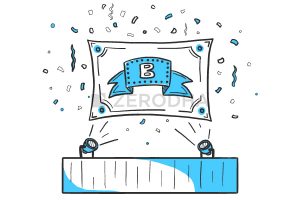

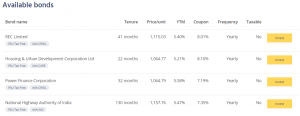
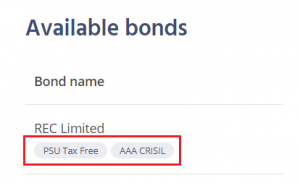

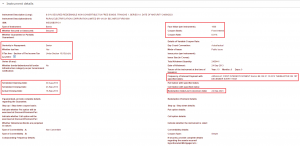
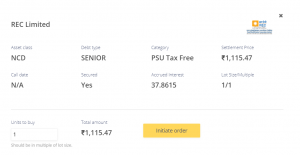
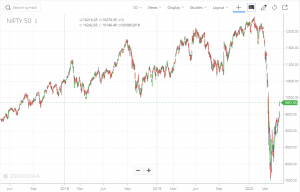
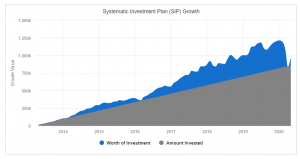
Hi Sir,
1) The bond feature is not available in my Coin app. Is it rolled out to everyone? From a Zerodha support ticket, it’s mentioned that it’s in internal testing state.
2) Can you also explain another set of categories in Bank bonds which are Tier 1 & Tier 2 bonds as per BASEL iii norms which will be more helpful to the readers. Also a Tier 2 bond can be a Subordinate/Senior bond and a Tier 1 bond can be a Senior bond. So if you could post the hierarchy for all those combinations, it will be more helpful.
3) Can you also please explain about NCD, Convertibles, Preferential shares? And will those also be listed in Coin app?
Appreciate your work on sharing your knowledge about investments to everyone.
Regards,
Tharun
1) It is still an internal beta, will be out soon
2) Will probably add more chapters related to bonds soon, will cover more topics.
Hi sr,
You know , apart from your financial aspects ,I have Learnt ,one prominent quality from You ie patience …almost Daily I check varsity for new chapters, Sorry to say but it was Very irritating initially, that there was a big time span between two chapters ,because it a human tenancy that we want everything fast and large ,you know more the merrier . ……..But later I realised quality takes time and you never compromise with that and now it makes me excited when I daily check varsity and wait for new chapter and new chapter is like diwali for me……….so sir from bottom of my heart I want to say ,you are an angel for financial knowledge seekers, I can understand your efforts and hardwork behind varsity and hope soon I’ll celebrate Diwali again..lol……hats off to you sr……
Thanks for all the kind words 🙂
Yeah, generating content takes time, at least for me. But I’ll try to speed up the process 🙂
Hi Karthik,
1) When a bond is issued, are YTM and Coupon rate same?
2) Why would one buy a bond at a premium when a bond at face or discounted value would have a better YTM? Also, do you not think 5.4% return is a li’l too less as a fixed deposit gives a better return?
3) Is the Clean price (in REC case 1077.609) the premium price of the bond?
1) Yup, thats right. As long as you hold to maturity
2) PSU bonds, which are tax-free are always sold at a premium, thanks to the implicit sovereign guarantee
3) Clean price, in this case, is still at a premium to the FV
1)They say ytm is like u reinvest the interest of the bond back into a similar bond,so it factors in wether payment is annual or semiannual also?
2)pls include ETF in future chapters and also explain more about bond purchasing and types of bond with advantage, disadvantage.Looking forward to newer chapters on personal finance
1) Yes, the frequency matters. Yeah, if you open a book on Fixed income, that is the typical definition you’ll find
2) Yup, will do that. Next up in Index funds 🙂
Hi Sir,
Thank you for all your (behind the scenes) efforts in creating these chapters so easy to understand for everyone.
Reading this chapter has led to an unusual doubt in my mind – when an investor purchase bond, he gets interest from it, but when he buys mutual fund (which holds that bond), the mutual fund get that interest which in turns increases the NAV of the mutual fund. Hope this understanding is correct?
In one of the AMCs debt fund portfolio, I saw them mentioning both annual return (8.04%) and YTM (5.70%), so why are they mentioning YTM when they are an open-ended scheme? Are they right in showing that? If yes, what does it then implies?
So will we be expecting a return of 8.04% or 5.70%?
Yes, that is right.
YTM represents the current yield. In the coming few chapters, I will discuss more on MF parameters and how to read them.